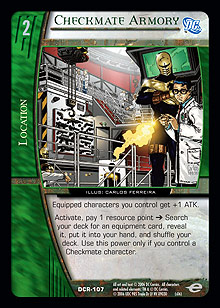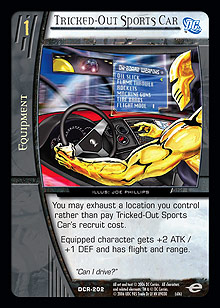
Welcome back for the final installment of Creating a Crisis. It’s a great opportunity for a game designer to be able to communicate directly with the players, but I have monopolized that time for too long. Starting next week, other members of R&D will share their views on Infinite Crisis and Vs. in general, all leading up to Heralds of Galactus previews in early August. For my last article, I want to take a look at the two major new keywords in Infinite Crisis: vengeance and backup.
Backup in the Beginning
Backup is the definitive Checkmate mechanic. Despite having one of the smallest introductions for a keyword in Vs. history (only seven cards feature the ability), it reflects a new way to think about characters in Vs., and you can expect to see backup explored more in future sets.
The development of backup is an interesting story that begins with our newest R&D hire, David Baumgartner. David has been working with us for about a year now, and he contributed to the design and development of The X-Men and Infinite Crisis. Since joining R&D, he has been trying to push the idea of a “sidekick” mechanic where some characters would have a primary role of assisting another character in play. This idea is very thematic for a comic book–themed game, and it has always intrigued me as an interesting design challenge. Most of the initial concepts for “sidekick” involved attaching a sidekick card to a character in play (much like equipment). The major problem with this idea is that you’d have characters “in play” that aren’t really in play. These sidekick equipment/character hybrids could clutter up the board and make analyzing a game state rather confusing. The sidekick idea clearly needed some refinement, but it had a lot of potential.
Backup to the Future
 Flash forward to the design of Infinite Crisis. I knew that I wanted the Checkmate team to be greater than the sum of its parts. As a secret government organization filled primarily with ordinary people—well, ordinary government-trained super-spies—Checkmate characters typically shouldn’t be going toe-to-toe with your average super hero. To support this idea, Checkmate was given location and equipment themes to reflect their reliance on secret bases and cool James Bond–esque weapons. But more than just relying on secret hideouts and expensive toys, I wanted Checkmate to rely on each other. In addition to our emphasis on the team working together to defeat more powerful enemies, I also enjoyed the irony that Checkmate’s story is really one of betrayal from within. I hoped to highlight this story by contrasting the power of the OMACs, who will sacrifice their allies to accomplish their own ends, with the team spirit of the human side of Checkmate. (For more on Checkmate’s back story, check out Ben Kalman’s excellent article on the subject.)
Flash forward to the design of Infinite Crisis. I knew that I wanted the Checkmate team to be greater than the sum of its parts. As a secret government organization filled primarily with ordinary people—well, ordinary government-trained super-spies—Checkmate characters typically shouldn’t be going toe-to-toe with your average super hero. To support this idea, Checkmate was given location and equipment themes to reflect their reliance on secret bases and cool James Bond–esque weapons. But more than just relying on secret hideouts and expensive toys, I wanted Checkmate to rely on each other. In addition to our emphasis on the team working together to defeat more powerful enemies, I also enjoyed the irony that Checkmate’s story is really one of betrayal from within. I hoped to highlight this story by contrasting the power of the OMACs, who will sacrifice their allies to accomplish their own ends, with the team spirit of the human side of Checkmate. (For more on Checkmate’s back story, check out Ben Kalman’s excellent article on the subject.)
 While he was trying to figure out how to make Checkmate characters work together, Dave once again brought up his sidekick idea. Checkmate really didn’t support the theme of sidekicks, but having some subordinate characters backup other characters certainly made a lot of sense. My first attempt at backup removed the character from the game to help solve the “clutter” problem of sidekick.
While he was trying to figure out how to make Checkmate characters work together, Dave once again brought up his sidekick idea. Checkmate really didn’t support the theme of sidekicks, but having some subordinate characters backup other characters certainly made a lot of sense. My first attempt at backup removed the character from the game to help solve the “clutter” problem of sidekick.
Checkmate Pawn
Recruit Cost: 2
Backup: Activate, remove this character from the game à Target character gets +1 ATK / +1 DEF this turn. At the end of the turn, return this character to your front row. Use this power only during the build phase.
This version of backup seemed pretty cool, but it was slightly non-interactive. Once a backup power was used, there wasn’t a way to stop it, and there was generally no way to remove backup characters from your opponent’s board. In addition, there is something distasteful about having a lot of characters popping in and out of play on a regular basis. Eventually, we decided to rely on the hidden area to serve the same function as the removed-from-game zone. This made backup considerably more interactive, as a well-timed Relentless Pursuit or Watch the Birdie! could take out a key backup character if necessary. To make the mechanic even more interactive, backup powers were originally tied to the backup character remaining in play and exhausted. This clause made it even more devastating when a backup character was taken out unexpectedly. In the end, we decided that this extra vulnerability wasn’t necessary. Only Valentina Vostok ◊ Negative Woman maintained the “while this remains exhausted” clause because of a devastating combo with The Rock of Eternity.
Since all of the backup characters have concealed or concealed—optional, players have to decide if it is worth giving up that character’s attack in order to gain its backup effect. This creates an interesting tension in most games involving backup. As regular readers of this article series know, however, I rarely make a drawback or cost without some way to “cheat” it with the right combo. The Rock of Eternity is probably the strongest combo with backup characters, allowing you to gain the benefit of their ability and still attack.
Vengeance is Mine!
The final design story of this series is a relatively straightforward one. I have talked elsewhere about the vengeance keyword and what it represents as the Villains United mechanic, but I have never revealed the origin of vengeance. This story involves the Senior Game Editor at UDE, Cate Muscat. See, in addition to being the person in charge of making sure every one of the thousands of cards we put out looks good, Cate is also my fiancee (I’m not sure which position requires more work). She and I play a great deal of Vs. together. While she’s a decent player, she has a lot less TCG experience than I do and thus would on occasion find herself with a board full of stunned characters and a dangerously low endurance total facing off against my unstunned team. One time when this happened, she complained that there should be a mechanic that rewards you for playing badly. I was intrigued; how would you create game mechanics that reward “bad play”? The idea itself is paradoxical, but rewarding players for typically bad play patterns certainly would shake things up. Thus, vengeance was born.
Seeing a Pro Circuit–level player gleefully swing Cheetah or Weather Wizard into a brick-wall defender before swinging with the rest of the team has been very amusing to me. The concept of rewarding bad play was also the inspiration for another major Crisis theme, Magic. Now when you find yourself at a very low endurance total with a board full of stunned characters, you might be doing exactly the right thing!
Well, that’s it for me. It has been a privilege to write this series and to help design a set for such a fantastic game. Designing Infinite Crisis was an incredible experience, and I hope that many of you enjoy playing with the set as much as I enjoyed working on it. I know that you will absolutely love what is coming next month in Heralds of Galactus. As always, please send feedback on this article, Infinite Crisis, or anything Vs. to Justin_Gary@upperdeck.com.